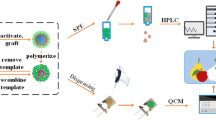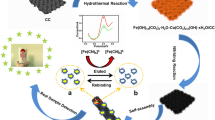Abstract
This study describes the development of a novel reproducible molecularly imprinted quartz crystal microbalance (QCM) sensor for the accurate and sensitive analysis of the residue of enrofloxacin (ENRO) in animal-derived foods. This proposed sensor was easily fabricated by directly immobilizing molecularly imprinted polymer (MIP) of ENRO on the surface of a QCM Au chip, which combined the advantages of selective recognition from the MIP with the high sensitivity and portability of a QCM sensor. The parameters in the fabrication and measurement process were optimized and discussed in detail. It was verified that the MIP-modified QCM Au chip performed favorably for the detection of ENRO residue in common animal-derived food products and demonstrated acceptable accuracy (recovery: pure milk 77.2–84.2%, egg 77.3–85.6%, chicken muscle 73.5–89.1%, pork 74.7–85.8%), precision (relative standard deviation (RSD, n = 3), pure milk 2.9–8.0%, egg 2.9–6.4%, chicken muscle 3.4–6.8%, pork 2.2–4.7%), and sensitivity (limit of detection, pure milk 0.31 μg L−1, egg 0.44 μg kg−1, chicken muscle 0.54 μg kg−1, pork 0.57 μg kg−1). The MIP-modified QCM Au chip for sensing ENRO was portable, could be stored for an extended period of time, and reused for more than 30 analysis cycles with a response attenuation of 7.8%. These results have demonstrated that the proposed MIP QCM sensor presents an accurate, sensitive, rapid, and low-cost methodology for ENRO residue detection in animal foods. This research is very promising for the development of novel effective devices applied to the detection of various contaminants in the field of food safety.






Similar content being viewed by others
References
Chen JX, Xu F, Jiang HY, Hou YL, Rao QX, Guo PJ, Ding SY (2009) A novel quantum dot-based fluoroimmunoassay method for detection of enrofloxacin residue in chicken muscle tissue. Food Chem 113(4):1197–1201
Chen Y, Sun J, Liao XP, Shao Y, Li L, Fang LX, Liu YH (2016) Impact of enrofloxacin and florfenicol therapy on the spread of OqxAB gene and intestinal microbiota in chickens. Vet Microbiol 192:1–9
Chopra S, Torres-Ortiz M, Hokama L, Madrid P, Tanga M, Mortelmans K, Kodukula K, Galande AK (2010) Repurposing FDA-approved drugs to combat drug-resistant Acinetobacter baumannii. J Antimicrob Chemoth 65(12):2598–2601
Di Gregorio MC, Jager AV, Costa AA, Bordin K, Rottinhghaus GE, Petta T, Souto PC, Budino FE, Oliveira CA (2016) Determination of aflatoxin B1-lysine in pig serum and plasma by liquid chromatography-tandem mass spectrometry. J Anal Toxicol. doi:10.1093/jat/bkw126
Guidi LR, Santos FA, Ribeiro AC, Fernandes C, Silva LH, Gloria MB (2017) A simple, fast and sensitive screening LC-ESI-MS/MS method for antibiotics in fish. Talanta 163:85–93
Guo T, Huang J, Zhang H, Dong L, Guo D, Guo L, He F, Bhutto ZA, Wang L (2016) Abcb1 in pigs: molecular cloning, tissues distribution, functional analysis, and its effect on pharmacokinetics of enrofloxacin. Sci Rep 6:32244
Ha MS, Chung MS, Bae DH (2016) Simple detection of residual enrofloxacin in meat products using microparticles and biochips. Food Addit Contam Part A Chem Anal Control Expo Risk Assess 33(5):817–823
Han DM, Fang GZ, Yan XP (2005) Preparation and evaluation of a molecularly imprinted sol-gel material for on-line solid-phase extraction coupled with high performance liquid chromatography for the determination of trace pentachlorophenol in water samples. J Chromatogr A 1100(2):131–136
Hormazábal V, Yndestad M (1994) Rapid assay for monitoring residues of enrofloxacin in milk and meat tissues by HPLC. J Liq Chromatogr R T 17(17):3775–3782
Huet A, Charlier C, Tittlemier SA, Singh G, Benrejeb S, Delahaut P (2006) Simultaneous determination of (fluoro)quinolone antibiotics in kidney, marine products, eggs, and muscle by enzyme-linked immunosorbent assay (ELISA). J Agr Food Chem 54(8):2822–2827
Hussain M, Kotova K, Lieberzeit PA (2016) Molecularly imprinted polymer nanoparticles for formaldehyde sensing with QCM. Sensors (Basel) 16(1011):9
Janusch F, Scherz G, Mohring SA, Hamscher G (2014) Determination of fluoroquinolones in chicken feces - a new liquid-liquid extraction method combined with LC-MS/MS. Environ Toxicol Pharmacol 38(3):792–799
Jha SK, Hayashi K (2015) A quick responding quartz crystal microbalance sensor array based on molecular imprinted polyacrylic acids coating for selective identification of aldehydes in body odor. Talanta 134:105–119
Ji S, Li N, Shen Y, Li Q, Qiao J, Li Z (2016) Poly(amino acid)-based thermoresponsive molecularly imprinted magnetic nanoparticles for specific recognition and release of lysozyme. Anal Chim Acta 909:60–66
Jiang C, Ji Y, Shi Y, Chen J, Cai T (2016) Sulfate radical-based oxidation of fluoroquinolone antibiotics: kinetics, mechanisms and effects of natural water matrices. Water Res 106:507–517
Wang JP, Pan MF, Fang GZ, Wang S (2009) Preparation of a novel molecularly imprinted polymer by a sol-gel process for on-line solid-phase extraction coupled with high performance liquid chromatography to detect trace enrofloxacin in fish and chicken samples. Microchim Acta 166:295–302
Kim NG, Kim MA, Park YI, Jung TS, Son SW, So B, Kang HG (2015) Magnetic nanoparticle based purification and enzyme-linked immunosorbent assay using monoclonal antibody against enrofloxacin. J Vet Sci 16(4):431–437
Kumar SA, Singh M (2015) QCM sensing of melphalan via electropolymerized molecularly imprinted polythiophene films. Biosens Bioelectron 74:711–717
Lee SJ, Desta KT, Eum SY, Dartois V, Cho SN, Bae DW, Shin SC (2016) Development and validation of LC-ESI-MS/MS method for analysis of moxifloxacin and levofloxacin in serum of multidrug-resistant tuberculosis patients: potential application as therapeutic drug monitoring tool in medical diagnosis. J Chromatogr B Analyt Technol Biomed Life Sci 1009-1010:138–143
Li M, Liu H, Ren X (2017) Ratiometric fluorescence and mesoporous structured imprinting nanoparticles for rapid and sensitive detection 2,4,6-trinitrophenol. Biosens Bioelectron 89:899–905
Lin L, Zhang Y, Tu X, Xie L, Yue Z, Kang H, Wu W, Luo Y (2015) Determination of 25 quinolones in cosmetics by liquid chromatography-tandem mass spectrometry. Se Pu 33:275–281
Liu S, Yan H, Wang M, Wang L (2013) Water-compatible molecularly imprinted microspheres in pipette tip solid-phase extraction for simultaneous determination of five fluoroquinolones in eggs. J Agr Food Chem 61(49):11974–11980
Liu W, Ma Y, Sun G, Wang S, Deng J, Wei H (2016) Molecularly imprinted polymers on graphene oxide surface for EIS sensing of testosterone. Biosens Bioelectron S0956-5663(16):31147–31142
Liu Y, Zhu L, Hu Y, Peng X, Du J (2017) A novel electrochemical sensor based on a molecularly imprinted polymer for the determination of epigallocatechin gallate. Food Chem 221:1128–1134
Mendil D, Demirci Z, Uluozlu OD, Tuzen M, Soylak M (2017) A new separation and preconcentration method for selenium in some foods using modified silica gel with 2,6-diamino-4-phenil-1,3,5-triazine. Food Chem 221:1394–1399
Palocz O, Gal J, Clayton P, Dinya Z, Somogyi Z, Juhasz C, Csiko G (2014) Alternative treatment of serious and mild Pasteurella multocida infection in New Zealand white rabbits. BMC Vet Res 10:276
Qian K, Deng Q, Fang G, Wang J, Pan M, Wang S, Pu Y (2016) Metal-organic frameworks supported surface-imprinted nanoparticles for the sensitive detection of metolcarb. Biosens Bioelectron 79:359–363
Rahman MM, Abd EA, Kim SW, Na TW, Shin HC, Hong SM, Shim JH (2017) A simple extraction method for the detection and quantification of polyoxin D, a nucleoside antibiotic, in butterbur using UPLC-MS/MS. Food Chem 221:683–688
Rocha DG, Santos FA, Da SJ, Augusti R, Faria AF (2015) Multiresidue determination of fluoroquinolones in poultry muscle and kidney according to the regulation 2002/657/EC. A systematic comparison of two different approaches: liquid chromatography coupled to high-resolution mass spectrometry or tandem mass spectrometry. J Chromatogr A1379:83–91
Shinohara S, Chiyomaru Y, Sassa F, Liu C, Hayashi K (2016) Molecularly imprinted filtering adsorbents for odor sensing. Sensors (Basel) 16(11):1194
Shumyantseva VV, Bulko TV, Baychorov I, Archakov AI (2015) Molecularly imprinted polymers in electro analysis of proteins. Biomed Khim 61(3):325–331
Sun X, Tian X, Zhang Y, Tang Y (2013) Molecularly imprinted layer-coated silica gel particles for selective solid-phase extraction of pefloxacin and enrofloxacin from milk samples. Food Anal Method 6(5):1361–1369
Terzopoulou Z, Papageorgiou M, Kyzas GZ, Bikiaris DN, Lambropoulou DA (2016) Preparation of molecularly imprinted solid-phase microextraction fiber for the selective removal and extraction of the antiviral drug abacavir in environmental and biological matrices. Anal Chim Acta 913:63–75
Wu X, Wu L (2015) Molecularly imprinted polymers for the solid-phase extraction of four fluoroquilones from milk and lake water samples. J Sep Sci 38(20):3615–3621
Yang Y, Wang Y, Niu R, Lu J, Zhu X, Wang Y (2016) Preparation and characterization of chitosan microparticles for immunoaffinity extraction and determination of enrofloxacin. Int J Biol Macromol 93:783–788
Zhao S, Jiang H, Li X, Mi T, Li C, Shen J (2007) Simultaneous determination of trace levels of 10 quinolones in swine, chicken, and shrimp muscle tissue using hplc with programmable fluorescence detection. J Agr Food Chem 55(10):3829–3834
Zhao Y, Zhang G, Liu Q, Teng M, Yang J, Wang J (2008) Development of a lateral flow colloidal gold immunoassay strip for the rapid detection of enrofloxacin residues. J Agr Food Chem 56(24):12138–12142
Zhou M, Peng J, He R, He Y, Zhang J, Li A (2015) High performance liquid chromatography coupled with resonance Rayleigh scattering for the detection of three fluoroquinolones and mechanism study. Spectrochim Acta A Mol Biomol Spectrosc 136:1181–1187
Acknowledgements
This work is financially supported by Tianjin Natural Science Foundation (No. 17JCQNJC14800), National Natural Science Foundation of China (Project No. 31301461), Basic Research Fees of Universities and Colleges in Tianjin (No. 2017KDZD01), and the Innovative Team project from Tianjin University of Science and Technology (Project No. 115004/0000010105).
Author information
Authors and Affiliations
Corresponding author
Ethics declarations
Conflict of Interest
Mingfei Pan declares that he has no conflict of interest. Ying Gu declares that she has no conflict of interest. Miyao Zhang declares that she has no conflict of interest. Junping Wang declares that he has no conflict of interest. Yaguang Yun declares that she has no conflict of interest. Shuo Wang declares that he has no conflict of interest.
Ethical Approval
All applicable international, national, and institutional guidelines for the care and use of animals were followed.
Informed Consent
Not applicable.
Electronic Supplementary Material
Figure S1
Comparison of QCM frequency response to ENRO and the analogues at the same concentrations. (GIF 31 kb)
Rights and permissions
About this article
Cite this article
Pan, M., Gu, Y., Zhang, M. et al. Reproducible Molecularly Imprinted QCM Sensor for Accurate, Stable, and Sensitive Detection of Enrofloxacin Residue in Animal-Derived Foods. Food Anal. Methods 11, 495–503 (2018). https://doi.org/10.1007/s12161-017-1020-1
Received:
Accepted:
Published:
Issue Date:
DOI: https://doi.org/10.1007/s12161-017-1020-1




